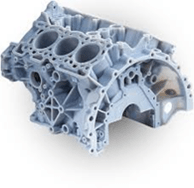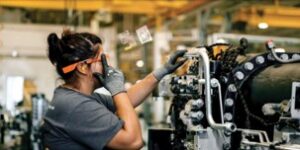Recent developments in the field of Industry-4.0 technologies have significant potential to be incorporated in Lean methodologies.
Additionally, working with the Digital Accelerator team at University of Wales Trinity St. David, over recent years, has given me a great deal of experience (and learning opportunities) of applying these technologies to enhance the performance of real companies.
As a consequence, this knowledge has been incorporated into our training offering in a range of courses we provide.
Examples of this being:
- Re-enforcing the Sustain element of 5S by developing safe and optimised working 5S procedures using Augmented reality systems. This offers significant opportunities for improving efficiency, quality and safety standards.
- Digital twinning, Additive manufacturing, Robotics, AR/VR, IoT, and advanced computer-aided design and engineering (CAD/CAE) have changed the Product development process. Designers can rapidly create prototypes and use online simulations for testing. This means that products can be brought to market significantly faster than using traditional methods.
- In Process Development, Additive and 3D manufacturing methods make it possible to produce customised, low-volume products without the requirement of expensive tooling and their associated lengthy pre-production processes.
- Using Augmented Reality Systems for managing Maintenance systems. By superimposing digital information directly on real objects or environments, AR allows maintenance procedures to become interactive 3-D holograms that walk the user through the necessary asset care processes. This can enhance the coverage and thus reliability of your maintenance systems thus reducing downtime significantly.
- IoT systems facilitate Predictive maintenance for optimising service timing : allowing businesses to know exactly when a piece of machinery needs repair. By fitting sensors to generate more data on machinery condition (even retrofitting these devices onto existing equipment), manufacturers can start to predict failure patterns before they happen. Again, downtime can be reduced significantly.
- Using Augmented Reality Systems for Pitstopping : optimisation Changeover efficiency. Using complicated 2-D schematic representations of a changeover procedure from a manual can be dificult. Using interactive 3-D holograms allow the operator to be guided efficiently through the optimal changeover processes. Reducing changeover time effectively means free extra capacity for the business.
- Using a Digital twin to optimise Process Design.The digital twin concept in process development allows simulation of a new piece of process equipment, not only in its design, but also in its physical performance, before any work is started in physically producing the process. Major cost savings can be realised in this way.
- AI techniques can reduce waste related to materials, energy, time, and space. This can take several forms, including coupling in-process monitoring to anomaly detection which activate POKA YOKE devices.
- On Bottleneck or capacity-limiting processes, if people related issues are a problem, then Cobots (Collaborative Robots) are a realistic option. They are particularly good substitutes for the type of tasks humans don’t like doing.
- Digital Print from the Cloud — Anywhere in the World. Additive cloud solutions empower on-demand part production through a digital inventory thus reducing reliance on traditional inventory and supply chain sources. As a result, users of Additive 3D printing technologies can restructure their business models to create parts whenever and wherever needed.
For more detail on these developments please get in touch by using the contact page on our website www.drjrt.com, or visit the “What we offer” page on the website for more information on these various technological developments.

